11 Actionable Content Marketing Tips for All Kinds of Marketers
Content marketing is constantly advancing, and you always need to keep your finger on the pulse to beat the competition. Whether you’re a beginner or an expert marketer, you need to refresh your marketing strategy every now and then.
We’ve made a complete guide with 11 proven tips to rock your content marketing efforts.
Here’s how to get the most of this article and put it to its best use for your marketing strategy.
- Thoroughly read each tip.
- Take notes and modify them for your market.
- Go through all the points and select 3 to 5 that you feel will best suit your niche and marketing goals.
- Lastly, take action. Even with trial and error, you’ll eventually get on the right track.
Now let’s dive in.
What is Content Marketing?
Content marketing is a type of digital marketing that aims to target a certain audience sector through content creation and distribution. It unites everything, from social and email marketing to video marketing and beyond.
For the past decade, digital marketing has been the primary promotional medium for brands. According to Datareportal, 62.5% of the world’s population uses the internet, so it’s clear why marketers have more chances to interact with their prospects online than through printed media.
Unlike traditional marketing, where you simply pitch your services or products to people, content marketing provides answers to their questions and relevant solutions to their issues. Content marketing caters to your prospects to take them through the sales funnel that leads to conversion.
Today, companies also often exploit content marketing to increase conversion rates, and this is where copywriting comes into play. The right content, be it an article, video, photo, or even a webinar, can help you get on top of the market and boost your brand reach.
Thus, content plays a vital role in marketing. No matter what strategy you employ, if you’re content underperforms, you’ll hardly ever make the leap.
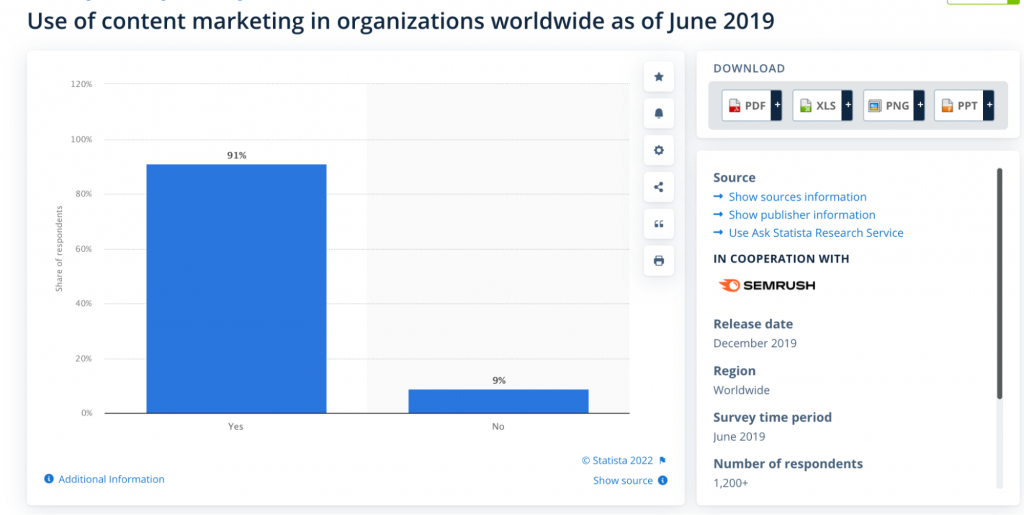
According to the statistics above, 91% of companies worldwide use content marketing to reach their branding goals. These numbers prove the importance of the content’s role in marketing.
Now, let’s dive into tips on how to take your content marketing to new heights. And, if you want to learn the basics, we invite you to check out our content marketing guide.
Tip #1: Know Your Audience
Knowing your audience helps you lay the foundation of your content strategy. If it shows no result, the chances are high that you’re targeting the wrong people.
So, what should you do to get to know your audience better?
You can use the famous tactic of the 5 W’s for effective content creation that targets your audience. Answer the following questions, and you’ll have a better image of your target group.
- Who are you creating content for?
- What content piece are you going to create?
- When will you distribute the content?
- Where will that content be published?
- Why are you creating the content, and how will you distribute it?
However, this may not be enough, and you might need narrower research on your prospect. This is when having buyer personas come in handy.
A buyer persona, also known as a content persona, is a fictional character based on deep research and analysis of your potential customers. You can use any data available to create your buyer profile, based on which you can develop your content marketing campaign. Tools like Google Analytics will provide the metrics that greatly help you understand your prospects’ preferences.
Once you have all the data on your audience, we also recommend using tools like HubSpot’s Make My Persona generator – you can use it to build a customer profile by answering basic questions:
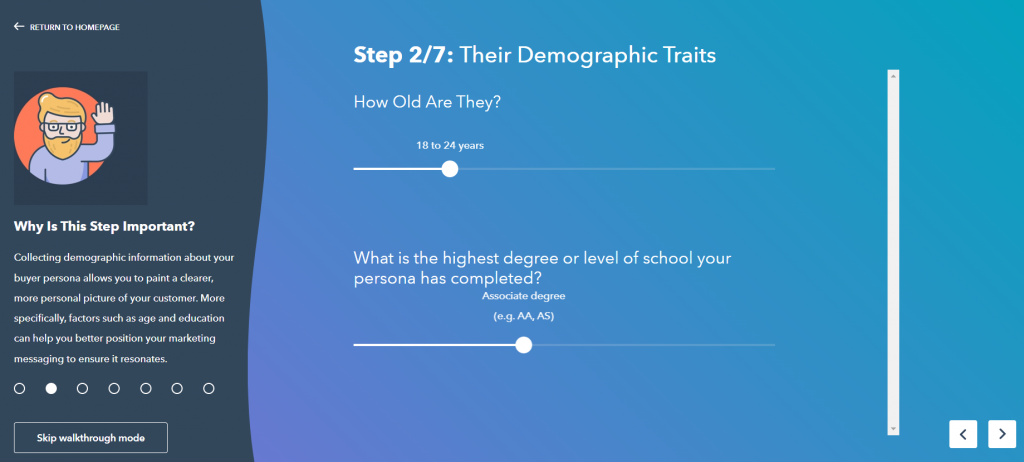
When you’re familiar with your audience, it’s easier to build a more efficient content marketing strategy.
Moving on to the next point.
Tip #2: Target the Right Search Intent
Since the search engine algorithms are constantly updating, you need to constantly keep an eye on them to make sure your content matches their requirements. Today, providing only SEO-optimized content is not enough to rank high in SERPs. To outcompete other pages in Google search, you need to deliver relevant content that matches your audience’s search intent.
There are four main types of search intent.
- Informational. Queries of informational intent usually contain the following words: how, when, who, why, etc. These queries have high search volume but are highly competitive.
- Commercial. Queries of commercial intent include terms such as online, app, alternative, best, review, and beyond. Usually, these types of queries have lower search volume.
- Navigational. This intent shows that the user is interested in certain information. It can be an address, contact number, or else. Terms that a navigational intent query includes are as follows: Sign in, Sign up, about, contact, and so forth.
- Transactional. This last one indicates that the user is determined to buy something. Queries of transactional intent included the following terms: buy, book, sale, rent, etc.
By targeting these search intents, you’ll notice a significant improvement in your website traffic. To understand your prospects’ search intent, you need to perform thorough data analysis using Google Analytics, Google Search Console as well as user behavior analysis.
Targeting the right search intent is key to increasing organic traffic. Of course, PPC can deliver the results quicker, but it still needs to correspond to the search intent. Moreover, the results of a PPC campaign don’t usually last long.
Want to know what content type is best for you? Keep on reading.
Tip #3: Find the Best Content Types
What’s great about content marketing is the diversity it provides. You can implement several great content types to reach your marketing goals, from articles, landing pages, videos, and case studies to quizzes and whatnot.
However, these content formats are not suited for all businesses. One of the actions you can take to understand what type of content works best for your brand is doing thorough competitor research. Check what content your competitors share and how it performs. This will help you better understand what content works best for your niche.
Also, you can always get help from statistics to understand what type of content people prefer. For instance, as you can see below, among the top 5 most popular video content types are music videos, viral videos, tutorials, live streams, and educational videos. Based on this data, you can start creating video content.
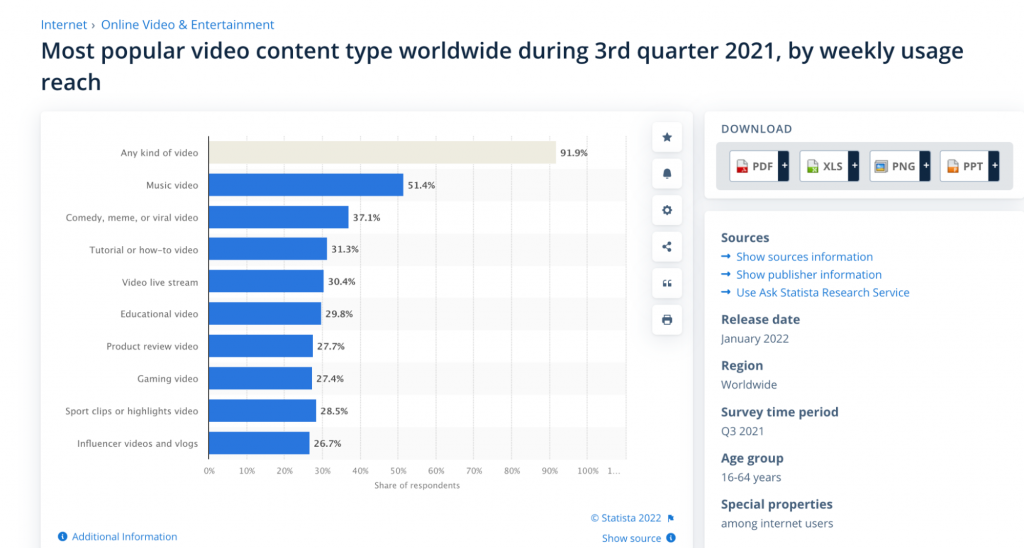
Also, you can use quizzes and surveys, which are another great option to help you gain ideal customer data. You can run quizzes on social media or send out surveys through email. Once you have enough data, you can start creating and distributing the right content based on your research.
Now off to the next tip.
Tip #4: Update Your Content
When the website is gaining traffic through organic search results, it can start losing traffic over time. To prevent this, you need to refresh your content to keep it up to date and retain high traffic. Besides, updating your older content can reel in new audiences, so why not do it?
But how do you know which content needs updating?
Have you ever heard about the content audit? If not, let us briefly introduce you to it.
The main aim of the content audit is to monitor the website, find and update underperforming content and increase website ranks.
The content audit has a number of benefits, such as:
- Helping you improve website optimization, including SEO.
- Showing you what your audience prefers.
- Providing valid data on the performance of your website, helping you make the right changes to your content.
- Finding pages that include information and visual content that need to be updated.
- Detecting pages that underperform in organic search results and need to be fixed.
- Finding pages that need to be updated to correspond to the current status of your product.
- Providing a full view of what works on your website and what needs improvement.
Content audits should be conducted on a regular basis to keep your content up to date and provide an error-free website performance.
To avoid constant updates, you can add evergreen content to your marketing strategy as it never goes out of style. However, it still needs to pass through a content audit from time to time.
Content repurposing is another form of content updating. Let’s discuss it in detail.
Tip #5: Repurpose Your Content
What’s great about content is the versatility it offers. One piece of content can be repurposed endlessly to fit various platforms. For instance, you can turn a successful YouTube video into an insightful article or a blog post into multiple social media posts, and so on.
Repurposing content is crucial since people have various tastes. Some prefer reading long articles, others look for simple images, and some like to watch videos. So, you need to put your content to various uses to get maximum results.
You can always give new life to your old content as well. By repurposing content, we not only imply adapting your content for various platforms but also reusing content you published years ago.
Here’s a great example from Neil Patel. A few years back, he made a YouTube video on finding specific keywords to rank high on Google:
Recently, he repurposed the video by publishing an article on the same topic, including some new tips.
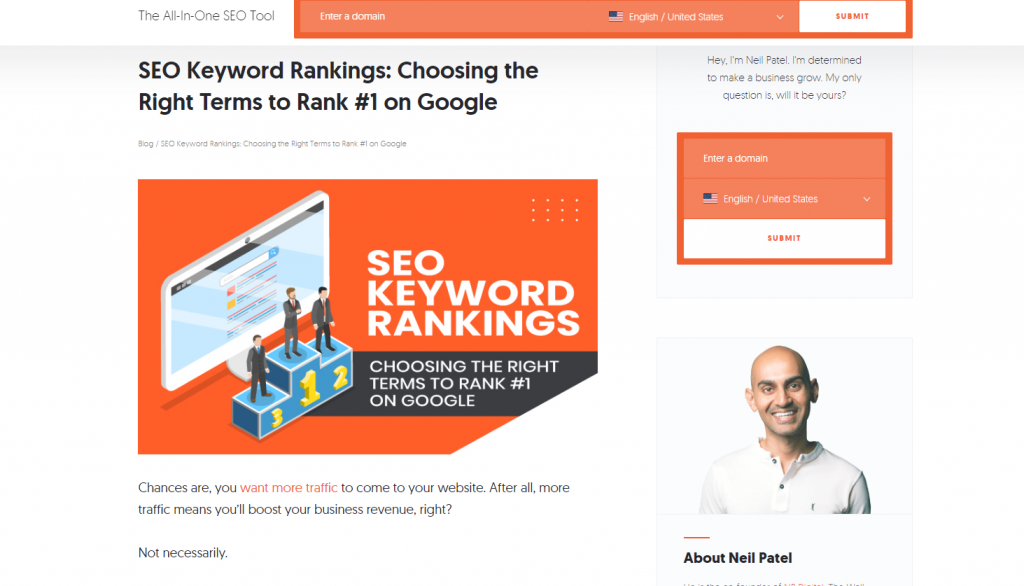
Another option is to turn your successful podcast episodes into articles.
Content marketing changes over time, so you need to freshen up your old content and adapt it to modern trends. Now, let’s see how you can distribute the content you created.
Tip #6: Distribute Your Content
Distribution is one of the main driving forces of content marketing. Why else would you need to create good content if you’re not planning to distribute it, right?
There are so many platforms where big ventures and small businesses can distribute content and reach their prospects, from Instagram, Pinterest, and YouTube to Facebook, LinkedIn, forums, newsletters, etc. The question is how to do it right.
The timing is one of the most critical factors in content distribution. And, to understand on which days and even hours to post on certain platforms, you need to turn to data for help. For instance, analyzing social data can help you figure out the best time to post on Facebook. For instance, the graph below shows that the optimal time is 11 AM:

In email marketing, some days can perform better than others. In general, the same content published at different times of the day can show a completely different performance.
Another popular type of content distribution is link building. The common method content marketers use for link building is guest posting. This is the perfect medium for distributing your content and increasing website traffic.
To ease your marketing workflow, you can create an editorial calendar where you can have all your posts scheduled so you don’t miss out on anything.
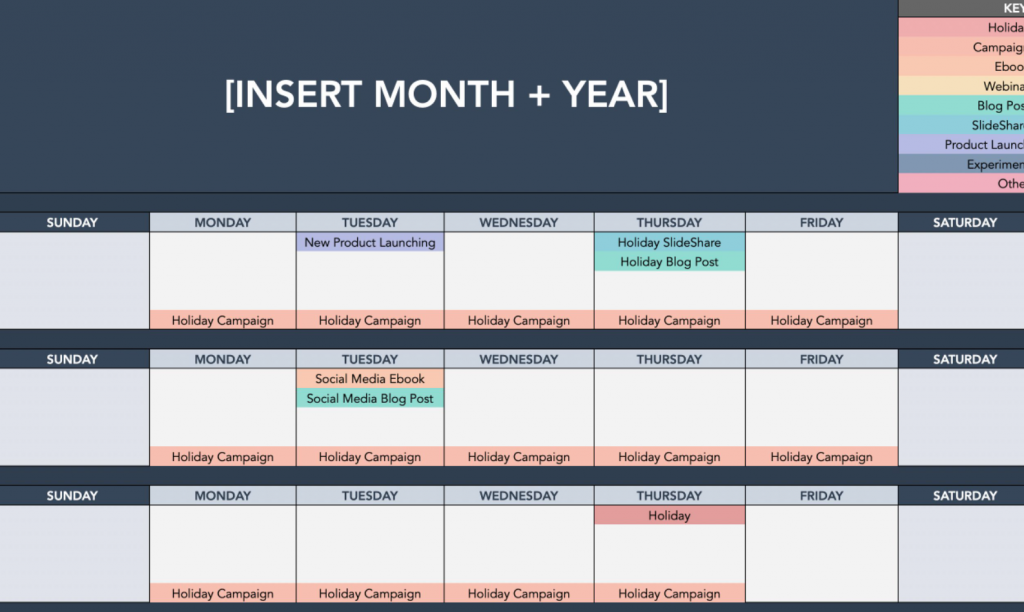
You can use the ready calendar template HubSpot offers or create your own.
Now on to the next marketing tip.
Tip #7: Be Unique
Today, the market is so repetitive and oversaturated that the only thing you can bet on to stay on top is uniqueness. It can be quite a task to stand out among the competition; that’s why you need to find your unique selling point that will set you apart from the rest.
There are two actions you can take here – competitor research and the personalization of your own content.
Competitor analysis will help you understand what your opponents share and make sure you’re not posting the same thing. Besides, figuring out what your competitor’s content lacks will help you find that unique touch and develop a successful content marketing strategy.
Personalization can also be the factor that brings authenticity to your content. A great example of that is one of Adidas campaigns. Back in 2017, the company launched an app for wish lists and gifts where people could answer a few questions to personalize the app. This way, the app provided personalized feeds by showing customers items based on their tastes:
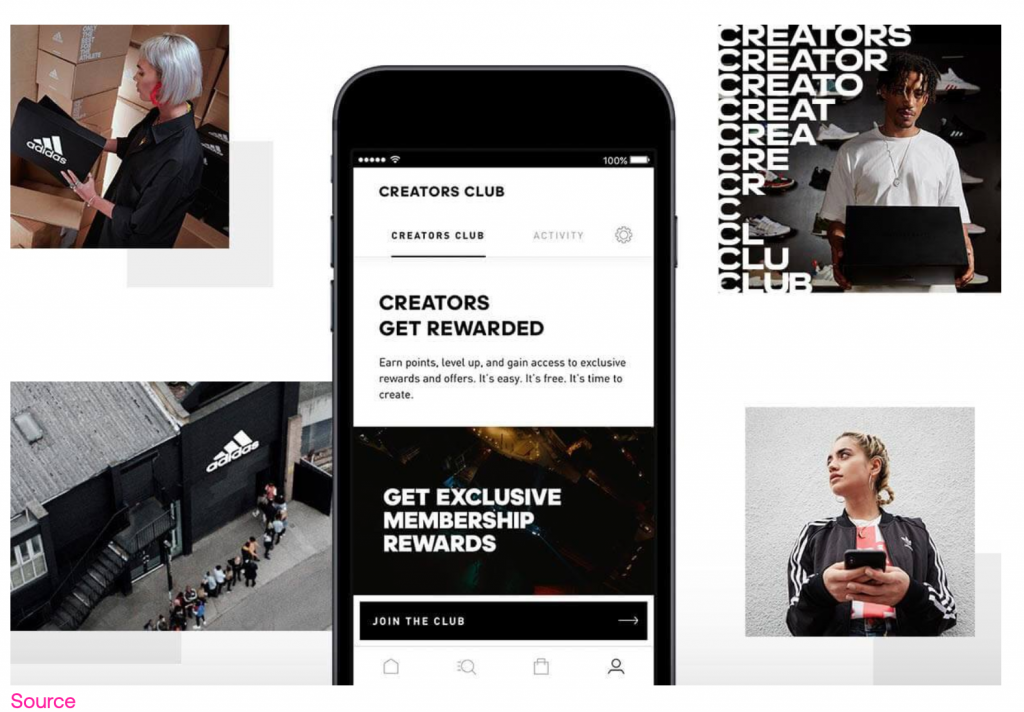
Now, let’s move on to the next content marketing trend.
Tip #8: Create Topic Clusters
Topic clusters are branches of one main topic, also known as the pillar topic. Simply put, you take one main topic and then link to the related ones. This action not only creates a better reading experience for your users but is also great for SEO.
Topic clusters are usually created to break down long-form content. For instance, if you have an extensive guide, like the one on brand awareness from Typeform, it helps structure the text better. Clustering also optimizes the page’s URL:

Here’s how you create a content cluster:
- Pick the pillar topic. First, you need to choose one topic for the clusters. It should reflect your brand’s and product’s primary purpose, and you should be able to break it down into multiple subtopics.
- Perform keyword research on the pillar topic. Just like with any other content writing, you need to provide keyword research for the pillar topic as well.
- Create an outline for the topic cluster. Focus on creating a very detailed content outline that will help you write a truly meaningful piece.
- Create content for the topic cluster. Once you have the outline and the list of keywords, you need to create high-quality content to support the topic clusters.
- Publish the content and link to all cluster topics. Here, remember that you might want to update the content later on. So, make sure it’s in your content calendar to keep this content relevant.
Following the above steps should help you get started with topic clusters.
Moving on to the next tip.
Tip #9: Align Your Content With Your Goals
Content marketing can have various goals for various types of businesses. For instance, it can aim to increase engagement or boost conversion rates. But you need to make sure that the type of content you distribute corresponds to your goals.
One of the main objectives every content marketer should set is lead generation. In this case, brands often create content for every sales funnel stage to increase the chances that a prospect will convert into a customer.
Revenue is another important goal your content can focus on, especially if you own an eCommerce business. In this case, you’ll be dealing primarily with copywriting, as its objective is to sell and generate revenue.
Also, don’t forget about brand awareness. In this case, besides blog content optimized for SEO, you might also need to run a few PPC and social media advertising campaigns to bring in more potential leads in support of your content marketing strategy.
Of course, it is possible that your content marketing strategy will focus on all three of these goals or on some more than on the others. That’s why it is important to track data to analyze your performance and do content audits from time to time to understand whether it caters to your goals or not.
Here’s another tip you can use for your content management.
Tip #10: Do Blogger Outreach
The popularity of influencer marketing has grown significantly over the past few years. Back in 2020, the influencer marketing budget increased by a significant 65%.
You can use this strategy to your benefit as well. Bloggers have large audiences ranging from thousands to millions of followers, who trust them and always reach out to them for advice and inspiration. This can work in your favor, especially if you want to get more relevant leads.
Influencers can sell your products or services better than you can imagine. All you need is to find the right blogger whose audience is similar to yours. To do so, you need to collect a list of relevant influencers. After that, you can check each of them through HypeAuditor to analyze their performance and audience:

If their activity fits your audience’s interests, you can try reaching out via email or direct messages. Once they respond, you can discuss the terms of your partnership.
You also need to take the platform into account. If most of your prospects prefer YouTube, then it will be wise to work with a vlogger. If your audience spends most of their time on Instagram, you can reach out to Instagram influencers. Social media provides the versatility to try and connect with your new customers or repeat clients basically anywhere.
Also, bloggers create credibility, and unlike regular campaigns, this is not a pushy, in-your-face advertisement. On the contrary, bloggers share their honest opinion and recommendations. That’s why you can engage them in an affiliate marketing program.
Now, let’s turn to the last tip on our list.
Tip #11: Be Interactive
Interactive content is an excellent way for marketers to attract their prospects on various platforms with engaging posts. For many years, interactive content has proven to increase engagement, drive traffic and boost conversion rates.
Let’s talk numbers here. According to recent statistics by the Content Marketing Institute and Ion Interactive, 53% of marketers are implementing interactive content. 66% of them admit that interactive content boosts customer engagement.
So what is interactive content?
Good examples of interactive content are quizzes, animated infographics, videos, and beyond. Interactive content involves user participation. So anything that can make prospects participate, be it sliding images, picking options, or else is interactive content.
Here’s a great example of interactive content where the viewers can choose how the rest of the video will continue. It teaches the viewers how to destroy debt, and the outcome will depend on their choices:
This video was created by Banqer, an online financial education platform, and it is definitely an awesome example of truly unique content.
So, adding interactive content to your marketing plan brings an array of benefits. Let’s sum them up:
- Increases engagement. People prefer interactivity over static content since it helps grasp and digest the information easier.
- Helps to get user feedback. With the implementation of interactive content, you can get more data from your users. For instance, quizzes and similar content help understand what your users like and dislike.
- Boosts conversion rates. Interactive content is highly beneficial for lead generation. You are more likely to convert a customer using interactive content pieces because they offer personalization.
The best part is that interactive content serves both B2C and B2B marketing strategy. Just make sure you choose the type that caters to your audience’s interests.
Now Over to You
Surely, these are not all the tips you can use to improve your content strategy. We’ll definitely cover more in our next articles, but for now, let’s recap what we’ve discussed today:
- Know who you are making content for
- Target the right search intent
- Find the best content types for your business
- Constantly update your old content
- Repurpose your content to reach a wider audience
- Make sure to distribute your content at the right time and place
- Find your unique voice to stand out among competitors
- Create topic clusters
- Make sure to align your content with your goals
- Reach out to bloggers for effective content marketing
- Create and share more interactive content
Hopefully, we managed to help you find exactly what your content marketing was lacking.
If you liked our tips, check out our blog, where we constantly post updates and insights on digital marketing.

Lilit is a passionate copywriter with a linguistic background. In addition to her love of content marketing, she enjoys learning new languages, strumming the guitar and reading science fiction. With her keen curiosity in marketing, she’s enthusiastic about sharing her knowledge through her articles.
